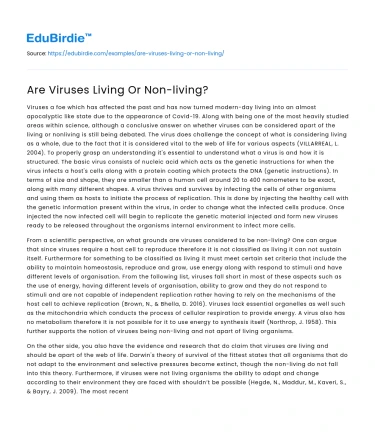Viruses a foe which has affected the past and has now turned modern-day living into an almost apocalyptic like state due to the appearance of Covid-19. Along with being one of the most heavily studied areas within science, although a conclusive answer on whether viruses can be considered apart of the living or nonliving is still being debated. The virus does challenge the concept of what is considering living as a whole, due to the fact that it is considered vital to the web of life for various aspects (VILLARREAL, L. 2004). To properly grasp an understanding it's essential to understand what a virus is and how it is structured. The basic virus consists of nucleic acid which acts as the genetic instructions for when the virus infects a host's cells along with a protein coating which protects the DNA (genetic instructions). In terms of size and shape, they are smaller than a human cell around 20 to 400 nanometers to be exact, along with many different shapes. A virus thrives and survives by infecting the cells of other organisms and using them as hosts to initiate the process of replication. This is done by injecting the healthy cell with the genetic information present within the virus, in order to change what the infected cells produce. Once injected the now infected cell will begin to replicate the genetic material injected and form new viruses ready to be released throughout the organisms internal environment to infect more cells.
From a scientific perspective, on what grounds are viruses considered to be non-living? One can argue that since viruses require a host cell to reproduce therefore it is not classified as living it can not sustain itself. Furthermore for something to be classified as living it must meet certain set criteria that include the ability to maintain homeostasis, reproduce and grow, use energy along with respond to stimuli and have different levels of organisation. From the following list, viruses fall short in most of these aspects such as the use of energy, having different levels of organisation, ability to grow and they do not respond to stimuli and are not capable of independent replication rather having to rely on the mechanisms of the host cell to achieve replication (Brown, N., & Bhella, D. 2016). Viruses lack essential organelles as well such as the mitochondria which conducts the process of cellular respiration to provide energy. A virus also has no metabolism therefore It is not possible for it to use energy to synthesis itself (Northrop, J. 1958). This further supports the notion of viruses being non-living and not apart of living organisms.
Save your time!
We can take care of your essay
- Proper editing and formatting
- Free revision, title page, and bibliography
- Flexible prices and money-back guarantee
On the other side, you also have the evidence and research that do claim that viruses are living and should be apart of the web of life. Darwin's theory of survival of the fittest states that all organisms that do not adapt to the environment and selective pressures become extinct, though the non-living do not fall into this theory. Furthermore, if viruses were not living organisms the ability to adapt and change according to their environment they are faced with shouldn’t be possible (Hegde, N., Maddur, M., Kaveri, S., & Bayry, J. 2009). The most recent form of an evolved virus that is known to everyone around the world at the moment is currently Covid-19 the coronavirus, the coronavirus is nothing new and has always been around but this strand has evolved and adapted causing it to be currently incurable by vaccine at this point. This further supports that viruses easily adapt to their surroundings and evolve just like other living organisms can. Another example of why viruses would be considering living is simply the fact that as virus do rely on a host for survival and replication, although humans also rely on many different aspects to sustain their own life such as oxygen created from plant life. Also, a study conducted In 1992 revealed large amounts of genes which were thought only to exists within cellular organisms present within viruses (VILLARREAL, L. 2004).
Once all evidence and research are looked at, it becomes clear that there is more heavily supported evidence suggesting that viruses are to be considered non-living rather than living entities. Especially from the criteria point of view for living organisms which was created by scientists. Therefore it's more-so acceptable to state that viruses are non-living due to the sheer amount of evidence and research that supports the non-living side of the debate. Conclusively more research is still being conducted and new supporting evidence for both ends are continuously emerging.






 Stuck on your essay?
Stuck on your essay?

